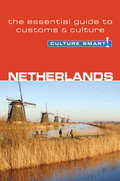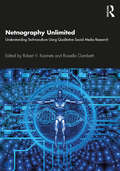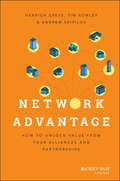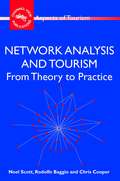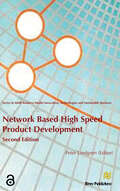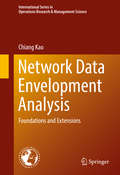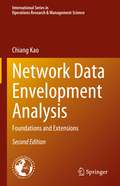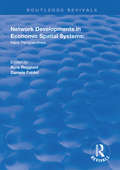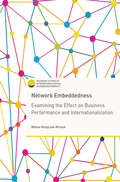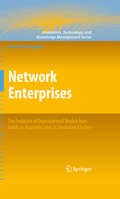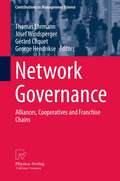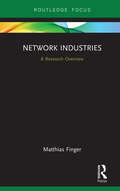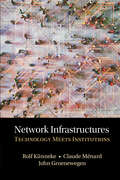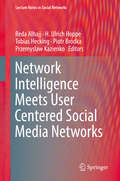- Table View
- List View
Netflixed: The Epic Battle for America's Eyeballs
by Gina KeatingNetflix has come a long way since 1997, when two Silicon Valley entrepreneurs, Marc Randolph and Reed Hastings, decided to start an online DVD store before most people owned a DVD player. They were surprised and elated when launch-day traffic in April 1998 crashed their server and resulted in 150 sales. Today, Netflix has more than 25 million subscribers and annual revenues above $3 billion. Yet long- term success-or even survival-is still far from guaranteed. Journalist Gina Keating recounts the absorbing, fast-paced drama of the company's turbulent rise to the top and its attempt to invent two new kinds of business. First it engaged in a grueling war against video-store behemoth Blockbuster, transforming movie rental forever. Then it jumped into an even bigger battle for online video streaming against Google, Hulu, Amazon, and the big cable companies. Netflix ushered in such innovations as DVD rental by mail, a patented online queue of upcoming rentals, and a recommendation algorithm called Cinematch that proved crucial in its struggle against bigger rivals. Yet for all its success, Netflix is still a polarizing company. Hastings is often heralded as a visionary-he was named Business Person of the Year in 2010 by Fortune-even as he has been called the nation's worst CEO. Netflix also faces disgruntled customers after price increases and other stumbles that could tarnish the brand forever. The quest to become the world's portal for premium video on demand will determine nothing less than the future of entertainment and the Internet. Drawing on extensive new interviews and her years covering Netflix as a financial and entertainment reporter, Keating makes this tale as absorbing as it is important.
Netherlands - Culture Smart!
by Sheryl BucklandCulture Smart! provides essential information on attitudes, beliefs and behavior in different countries, ensuring that you arrive at your destination aware of basic manners, common courtesies, and sensitive issues. These concise guides tell you what to expect, how to behave, and how to establish a rapport with your hosts. This inside knowledge will enable you to steer clear of embarrassing gaffes and mistakes, feel confident in unfamiliar situations, and develop trust, friendships, and successful business relationships.Culture Smart! offers illuminating insights into the culture and society of a particular country. It will help you to turn your visit-whether on business or for pleasure-into a memorable and enriching experience. Contents include* customs, values, and traditions* historical, religious, and political background* life at home* leisure, social, and cultural life* eating and drinking* do's, don'ts, and taboos* business practices* communication, spoken and unspoken"Culture Smart has come to the rescue of hapless travellers." Sunday Times Travel"... the perfect introduction to the weird, wonderful and downright odd quirks and customs of various countries." Global Travel"...full of fascinating-as well as common-sense-tips to help you avoid embarrassing faux pas." Observer"...as useful as they are entertaining." Easyjet Magazine"...offer glimpses into the psyche of a faraway world." New York Times
Netherlands Yearbook of International Law 2017: Shifting Forms and Levels of Cooperation in International Economic Law: Structural Developments in Trade, Investment and Financial Regulation (Netherlands Yearbook of International Law #48)
by Fabian Amtenbrink Ramses A. Wessel Denise PrévostThis Volume of the Netherlands Yearbook of International Law explores emerging trends and key developments in international economic law. It examines shifts in the levels of cooperation (from multilateral to plurilateral, regional or bilateral—or vice versa), and shifts in the forms of cooperation (new types of actors and instruments). These trends are analysed both from a conceptual and a practical perspective, with contributions addressing drivers for change, historical perspectives, future developments, and evolutions in specific policy fields. While a focus on international economic law may certainly not tell the whole story in relation to shifts in levels and forms of international cooperation, it does allow for a more detailed analysis of some of the important trends we currently witness.The Netherlands Yearbook of International Law was first published in 1970. It offers a forum for the publication of scholarly articles in a varying thematic area of public international law.
Netherlands Yearbook of International Law 2022: Reparations in International Law: A Critical Reflection (Netherlands Yearbook of International Law #53)
by Julie Fraser Otto Spijkers Emmanuel GiakoumakisThis book on international law explores the ways in which traditional forms of reparation (restitution, compensation, and satisfaction) have been (re)interpreted since the rendering of the landmark Factory at Chorzów judgment in 1928 of the Permanent Court of International Justice. It examines how the concept of reparations has developed in international law and evolved to reflect broader community values like human rights, as well as criminal and transitional justice. Contributions to this year’s volume of the Netherlands Yearbook of International Law examine the ways in which reparation has been understood in the jurisprudence of various courts and jurisdictions including the International Court of Justice, the International Criminal Court, and the UN human rights treaty body system. Several regional or internationalised bodies are also examined, including the Inter-American and European Courts of Human Rights and the Extraordinary Chambers in the Courts of Cambodia. The volume includes chapters focusing on recent efforts to repair historical wrongs — such as reparations for colonial times, dictatorial oppression, and failed peacekeeping missions — and the ways in which the legal principle of reparation has been conceptualised in support of these claims. The book illustrates the shift of reparations from a largely state-centric approach concerned with financial compensation, to a more victim-centred one that encompasses a diverse range of reparative measures. Despite this positive shift, multiple complex obstacles remain in the way of victims realising their right to reparation, including limited financial resources, ineffective victim consultation, long delays, and the absence of political will. The Netherlands Yearbook of International Law was first published in 1970. It offers a forum for the publication of scholarly articles in a varying thematic area of public international law. Chapter 13 is available open access under a Creative Commons Attribution 4.0 International License via link.springer.com.
Netnography Unlimited: Understanding Technoculture using Qualitative Social Media Research
by Robert V. KozinetsNetnography has become an essential tool for qualitative research in the dynamic, complex, and conflicted worlds of contemporary technoculture. Shaped by academic fields, industries, national contexts, technologies and platforms, and languages and cultures for over two decades, netnography has impacted the research practices of scholars around the world. In this volume, 34 researchers present 19 chapters that examine how they have adapted netnography and what those changes can teach us. Positioned for students and researchers in academic and professional fields, this book examines how we can better use netnographic research to understand the many ways networked technologies affect every element of contemporary business life and consumer existence. Netnography Unlimited provides an unprecedented new look at netnography. From COVID-19 to influencer empathy, gambling and the Dark Web to public relations and the military, AI and more-than-human netnography to video-streaming and auto-netnography, there has never been a wider or deeper treatment of technocultural netnographic research in one volume. Readers will learn what kind of work they can do with netnography and gain an up-to-date understanding of the most pressing issues and opportunities. This book is a must-read for those interested in technology, research methods, and contemporary culture.
Netscape's Initial Public Offering
by W. Carl Kester Kendall BackstrandIn August 1995, Netscape's board of directors was confronted with a decision about what price to offer the company's shares in its initial public offering (IPO). Preliminary demand for shares was high, but the company had not generated any positive earnings at the time of the offering.
Nettwerk: Digital Marketing in the Music Industry
by John Deighton Leora KornfeldHow is music marketed in the digital era? Nettwerk Music Group built on its foundation as a social, grassroots marketer of music and artists, and emerged as a leader in the Internet-enabled social media environment. For most of the past decade Nettwerk CEO Terry McBride let fans consume music on their own terms. He encouraged file-sharing, the remixing of his artists' songs and videos, and an environment in which "the audience is the record company." In the digital marketplace compact discs mattered much less, said McBride. "Digital assets" were the currency, in the form of ad, television, movie, and videogame song placement, ringtones, mixes, and community-created content. But new artist-label contracts were needed if digital assets were going to flow freely. Moving away from the infrastructure of the music business also meant having to do without the financial, logistical, and promotional power of the major labels. To provide an alternative to the muscle of the major labels, the company is launching a venture capital project called "Polyphonic."
Network Access, Regulation and Antitrust (The Economics of Legal Relationships)
by Diana L. MossThe rapid growth of network industries has generated much comment amongst academics and policy makers. This timely volume takes an interdisciplinary, case study-based approach to examining network issues and experiences in order to develop recommendations that can inform antitrust, regulatory and legislative policy. Legal, economic, political and institutional aspects of network access are analyzed. The first part of the volume focuses on five topics that are central to reasoned analysis of the access problem. The second part presents ten case studies of network access in the energy, transportation, telecommunications, internet and banking industries. The volume concludes with comparisons and contrasts across the cases and policy recommendations. Network Access, Regulation and Antitrust will prove invaluable to students of business, economics, law and economics and industrial economics, policy makers and academics working in the field.
Network Advantage
by Tim Rowley Andrew Shipilov Henrich GreveCompanies made more than 42,000 alliances over the past decade worldwide, many of which failed to deliver strong results. This book explains why and how you can seize the benefits from your business's network of alliances with customers, suppliers and competitors. This network can provide three key advantages:· superior information· better cooperation· increased power Network Advantage shows how awareness of these three advantages can help align your portfolio of alliances with your corporate strategy to maximize advantages from existing networks and to position your business as an industry leader.This book is written by three leading authorities in the field of organizational management who work with many international corporate clients. Based on groundbreaking research and illustrative cases, it provides practical tools to help you think strategically about reconfiguring your alliances and partnerships. For business executives, consultants, and executive MBAs who want to get the most advantage from the combined power of their alliance portfolios, Network Advantage offers in-depth, practical guidance. Make it your first strategic connection to gaining competitive advantage!Companies' connections to other firms--their network of alliances--matter for economic success. In this practical, jargon-free, evidence-based book, three experienced scholar/educators provide practical tools to understand your company's network positioning and what to do to build webs of relationships that provide competitive advantage and economic value.--Jeffrey Pfeffer, professor, Graduate School of Business, Stanford University and co-author of The Knowing-Doing Gap.The book, Network Advantage, presents compelling ideas and is a must-read. It articulates three different perspectives to think about a firm's network advantage and shows how a firm can maximize the value of its alliance network. The book is filled with theoretical and practical insights on the topic and offers captivating case studies to illustrate its key points. It is fun to read. I highly recommend this book.--W. Chan Kim, The BCG Chair Professor of INSEAD and the Co-director of the INSEAD Blue Ocean Strategy InstituteIn this eminently researched book, the authors show how executives and entrepreneurs alike can unlock the value of alliances. And the book comes with some "secrets" to success that most managers overlook. Every CEO, executive and entrepreneur who are collaborating with other firms ought to read this book. --Morten T. Hansen, Professor at University of California at Berkeley, author of Collaboration and co-author of Great by Choice.Don't compete alone! "Network Advantage" provides a fresh perspective on how all firms can benefit from their alliances and partnerships. The authors seamlessly integrate academic research and real life examples into a practical step by step guide for unleashing the power, information and cooperation advantages available in networks. A must read for thoughtful executives and entrepreneurs alike. --Stein Ove Fenne, President, Tupperware U.S. & Canada Having the "right" business network is everything for a company's success in Asia and worldwide. With its rich cases and practical tools, this book is an indispensable guide for a thoughtful executive on how to design, build and manage a network that will make your firm globally competitive. --Yong-Kyung Lee, Former CEO of Korean Telecom, Member of the Korean National Assembly. Alliances and Partnerships, in their various formats and guises, are the bridges that allow businesses to thrive in their ecosystems by leveraging each other's strengths. The authors show how those bridges, when used appropriately, can help your firm create an alliance network to enhance your business power. The book contains many examples and models to help you shape your own alliance strategy in a world of ever increasing co-opetition.--Ricardo T. Dias, Strategic Alliances Director, Hewlett Packard (HP) Software, Asia Pacific & Japan
Network Analysis and Tourism
by Rodolfo Baggio Noel ScottThis book aims to provide a comprehensive review of the contribution of network analysis to the understanding of tourism destinations and organizations. Theoretical and methodological aspects are discussed along with a series of applications. While this is a relatively new approach in the tourism literature, in other social and natural sciences network analysis has a long tradition and has provided important insights for the knowledge of the structure and the dynamics of many complex systems. The study of network structures, both from a quantitative and qualitative point of view, can deliver a number of useful outcomes also for the analysis of tourism destinations and organizations.
Network Assessment Exercise: Abridged MBA Version
by Herminia IbarraDesigned to help students identify patterns in their approaches to developing networks of relationships. A "network" refers to the set of relationships that help people to advance professionally, get things done, and more generally, develop personally and professionally. A rewritten version of an earlier exercise.
Network Assessment Exercise: Abridged MBA Version
by Herminia IbarraDesigned to help students identify patterns in their approaches to developing networks of relationships. A "network" refers to the set of relationships that help people to advance professionally, get things done, and more generally, develop personally and professionally. A rewritten version of an earlier exercise.
Network Assessment Exercise: Executive Version
by Herminia IbarraDesigned to help executives identify patterns in their approaches to developing networks of relationships. A "network" refers to the set of relationships that help people to advance professionally, get things done, and more generally, develop professionally and personally. A rewritten version of an earlier exercise.
Network Based High Speed Product Development
by Peter LindgrenIn the first decade of the 21st century product development in networks was predicted to be of ever-increasing importance to businesses of all sizes because of changes in markets, in technology, in networks, and in the competences of Businesses. The growth in new products’ share of businesses’ total turnover and earnings were increasing at an unprecedented speed. The entrepreneurial innovations and technological improvements had resulted in the increasingly fast development of new products and services. Businesses and industries in different countries became increasingly more linked and interdependent in networks with respect to materials, business operations and particularly product development to match the wants and needs of the global market environment to high speed product development. Businesses were therefore encountering increasingly dynamic market fragmentation, shrinking time in market, increasing product variety, demands of production to customer specifications, reduced product lifetimes, and globalization of production.Networks were vital because the competition is not business against business, but network against network. Networks are vital because an increasing part of product development was carried out in all types of networks containing physical, ICT, dynamic, and virtual networks. Speed and pressure on time in product development seemed to continue to increase because customer demands for new products seemed to continue to increase. However, a Business seldom possessed all needed competences, and managers saw product development based on networks as an important solution to meet the strong competition of the future global markets and the strong demand for innovation and innovativeness. The evolution of market demands and focus (required) on competencies of businesses could be characterized as a development from a focus on efficiency, to a focus on quality and flexibility, to a focus on speed and innovativeness.This was why it was interesting and important to research and discuss product development and especially to understand high speed product development of individualized products in fragile market segments. Consequently, findings and learning on aspects like enablers, management tools, technological tools, product development models, product development processes and network tools to speed new product development are presented in this book.
Network Data Envelopment Analysis
by Chiang KaoThis book presents the underlying theory, model development, and applications of network Data Envelopment Analysis (DEA) in a systematic way. The field of network DEA extends and complements conventional DEA by considering not only inputs and outputs when measuring system efficiency, but also the internal structure of the system being analyzed. By analyzing the efficiency of individual internal components, and more particularly by studying the effects of relationships among components which are modeled and implemented by means of various network structures, the "network DEA" approach is able to help identify and manage the specific components that contribute inefficiencies into the overall systems. This relatively new approach comprises an important analytical tool based on mathematical programming techniques, with valuable implications to production and operations management. The existing models for measuring the efficiency of systems of specific network structures are also discussed, and the relationships between the system and component efficiencies are explored. This book should be able to inspire new research and new applications based on the current state of the art. Performance evaluation is an important task in management, and is needed to (i) better understand the past accomplishments of an organization and (ii) plan for its future development. However, this task becomes rather challenging when multiple performance metrics are involved. DEA is a powerful tool to cope with such issues. For systems or operations composed of interrelated processes, managers need to know how the performances of the various processes evaluated and how they are aggregated to form the overall performance of the system. This book provides an advanced exposition on performance evaluation of systems with network structures. It explores the network nature of most production and operation systems, and explains why network analyses are necessary.
Network Data Envelopment Analysis: Foundations and Extensions (International Series in Operations Research & Management Science #340)
by Chiang KaoThis second edition systematically presents the underlying theory, model development, and applications of network Data Envelopment Analysis (DEA). It discusses the models used to measure the efficiency of systems in specific network structures and introduces readers to the latest applications. It demonstrates how the “network DEA” approach helps identify and manage the specific components that cause inefficiencies in the overall system. The existing models for measuring the efficiency of systems in specific network structures are also discussed, and the relationships between system efficiency and component efficiency are explored. Moreover, the book provides an advanced exposition on performance evaluation of systems with network structures. It explores the networked nature of most production and operation systems, and explains why network analyses are necessary. Accordingly, the book will inspire new research and applications based on the state of the art. In this new edition, the latest research advances and discoveries are discussed. Two new chapters on Linkage Efficiency and External and Internal Evaluations have been added. This book is mainly aimed at researchers and graduate students who are interested in performance evaluation, DEA, and multi-criteria decision analysis. Practitioners who want to measure the performance of production, operation, or any type of decision-making units will also find it useful.
Network Developments in Economic Spatial Systems: New Perspectives (Routledge Revivals)
by Aura Reggiani Daniele FabbriFirst published in 1999, the main feature of this book is its multidisciplinary nature, since the book focuses on the complexity of spatial/ economic networks from several methodological points of view. For this purpose both theoretical and empirical works have been included. The aim of the book is to provide an updated and fresh look at the mentioned issue with innovative and creative papers coming from leading experts belonging to different disciplines. Therefore the book could be considered as an expert and critical guide - through different methodological approaches - to the topic of (complex) networks in the space-economy. All the contributions provide innovative and in some cases provocative elements to the understanding of networks and development over space.
Network Economics and the Allocation of Savings
by Philipp ServatiusThis book provides a game theoretic model of interaction among VoIP telecommunications providers regarding their willingness to enter peering agreements with one another. The author shows that the incentive to peer is generally based on savings from otherwise payable long distance fees. At the same time, termination fees can have a countering and dominant effect, resulting in an environment in which VoIP firms decide against peering. Various scenarios of peering and rules for allocation of the savings are considered. The first part covers the relevant aspects of game theory and network theory, trying to give an overview of the concepts required in the subsequent application. The second part of the book introduces first a model of how the savings from peering can be calculated and then turns to the actual formation of peering relationships between VoIP firms. The conditions under which firms are willing to peer are then described, considering the possible influence of a regulatory body.
Network Embeddedness
by Milena Ratajczak-MrozekThis book systematizes the concepts of business relationships and network embeddedness, taking a new approach to internationalization, relevant for the global economy. It reflects the growing importance of network internationalization theory and explores the impact of embeddedness in domestic and foreign relationships on a company's performance. The author questions the validity of the distinction between domestic and foreign activity of companies and demonstrates that in the B2B market, there are actually no exclusively domestic companies which are not directly or indirectly connected with foreign entities. Chapters cover both small to medium sized enterprises and large multinational corporations, presenting a qualitative analysis of over 400 companies including case studies from the IT and furniture industries. This informative study will provide useful insight for academics and students of business and management, international business and organization studies.
Network Enterprises
by Gianfranco DioguardiBuilding on the historical analysis of organizations and theories that have influenced their development, Gianfranco Dioguardi provides an insightful exploration of the network enterprise and its evolution from the Medieval guilds to the present innovation clusters of Silicon Valley, the Research Triangle, Route 128, and other regions in the U.S and around the world. Providing in-depth analysis of production systems and the evolution of "lean manufacturing" principles, Dioguardi integrates history, sociology, management theory, and economics to explore the dynamics of organizations that operate as networks and interact with other firms along the supply chain and in complementary industries. In a technology-enabled environment, the boundaries between products and services and across enterprises become blurred--and create the context for entrepreneurship, innovation, and dissemination of knowledge. Several chapters are devoted to practical concerns of managing the network enterprise, with a particular interest in the ethical and cultural issues. Dioguardi concludes with discussion of the role of the network enterprise in new firm creation and economic growth.
Network Governance
by Gérard Cliquet George Hendrikse Josef Windsperger Thomas EhrmannThe current book on Nework Governance contributes to the literature by offering new perspectives on network goals and performance, inter-organizational learning and trust in alliances, corporate governance issues in cooperatives, governance of cross-border retail networks, contract design and governance innovations in cooperatives and fanchising.
Network Governance and Energy Transitions in European Cities (Routledge Focus on Energy Studies)
by Timea NochtaThis book investigates and evaluates the opportunities and limitations of network governance in building local capacity for energy infrastructure governance. Presenting a comparative analysis of three city cases from across Europe- Birmingham, Frankfurt and Budapest- this book demonstrates how local factors shape the prospect of network governance to support low-carbon energy transitions. It maps out existing governance networks, highlighting the actors involved and their interactions with one another, and also discusses the role and embeddedness of networks in the urban governance of low-carbon energy. Drawing on case study evidence, Nochta develops a comparative analysis which discusses the intricate connections between network characteristics, context and impact. It highlights that organisational fragmentation; the complexity of the low-carbon energy problem and historical developments all influence network characteristics in terms of degree of integration and vertical (hierarchical) power relationships among network actors. Overall, the book concludes that understanding such links between context and networks is crucial when designing and implementing new governance models aimed at facilitating and governing low-carbon urban development. Low-Carbon Energy Transitions in European Cities will be of great interest to scholars of energy policy, urban governance and sustainability transitions.
Network Industries: A Research Overview (State of the Art in Business Research)
by Matthias FingerThe unique challenges associated with understanding network industries requires insights from a range of disciplinary perspectives, namely economics, engineering, law, and political science. This book analyzes the de- and re-regulation of the network industries and the regulatory challenges these industries will face in the future. Network industries are characterised by economics that entail limiting effects on competition and market creation, and the book highlights the drivers behind their liberalization as well as the inherent need for regulation as liberalization unfolds. By way of an historical approach, the author offers insights into the distinctive approaches between Europe and North America in the past whilst also presenting the pervasive role digitalization increasingly comes to play. A concise overview of the state of thinking about the network industries, this book will be vital reading for researchers, advanced students and practitioners.
Network Infrastructures: Technology meets Institutions
by John Groenewegen Claude Ménard Rolf KunnekeInfrastructures are complex networks dominated by tight interdependencies between technologies and institutions. These networks supply services crucial to modern societies, services that can be provided only if several critical functions are fulfilled. This book proposes a theoretical framework with a set of concepts to analyse rigorously how these critical functions require coordination within the technological dimension as well as within the institutional dimension. It also shows how fundamental the alignment between these two dimensions is. It argues that this alignment operates along different layers characterized successively by the structure, governance and transactions that connect technologies and institutions. These issues of coordination and alignment, at the core of the book, are substantiated through in-depth case studies of networks from the energy, water and wastewater, and transportation sectors.
Network Intelligence Meets User Centered Social Media Networks (Lecture Notes in Social Networks)
by Reda Alhajj H. Ulrich Hoppe Tobias Hecking Piotr Bródka Przemyslaw KazienkoThis edited volume presents advances in modeling and computational analysis techniques related to networks and online communities. It contains the best papers of notable scientists from the 4th European Network Intelligence Conference (ENIC 2017) that have been peer reviewed and expanded into the present format. The aim of this text is to share knowledge and experience as well as to present recent advances in the field. The book is a nice mix of basic research topics such as data-based centrality measures along with intriguing applied topics, for example, interaction decay patterns in online social communities. This book will appeal to students, professors, and researchers working in the fields of data science, computational social science, and social network analysis.

